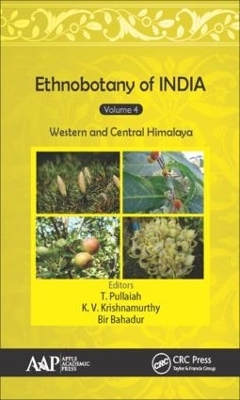
Ethnobotany of India, Volume 4
Apple Academic Press Inc. (Verlag)
978-1-77188-550-8 (ISBN)
Volume 1: Eastern Ghats and Deccan
Volume 2: Western Ghats and West Coast of Peninsular India
Volume 3: North-East India and Andaman and Nicobar Islands
Volume 4: Western and Central Himalayas
Volume 5: The Indo-Gangetic Region
Each volume looks at the important ethnic plants of the specific region. Volume 4 covers the Western and Central Himalayas, the well-known mountain range on the Indian subcontinent. The unique flora and fauna of the Himalayas are varied, affected by climate, rainfall, altitude, and soils, and are vulnerable to impacts from climate change. The editors espouse that because indigenous non-Western societies form the vast majority of people now as well as in the past, a study of their plant interrelationships is necessary, and India is one of the most important regions of the old world for its ancient and culturally rich and diverse knowledge of ethnobotany. With this in mind, these volumes share a great deal of information that will be valuable to plant botanists and others working in and interested in ethnobotany.
This important volume covers the ethnobotanical aspects of many plants of the region. It looks at
ethnic diversity of people
ethnic food plants and food preparation
ethnomedical aspects of plants
psychedelic plants and their possible link to soma, a vedic ritual drink whose plant origins are a mystery
ethnoveterinary medicinal plants
ethno-conservation practices
biodiversity heritage sites
The volume includes the details of the plants used, their scientific names, the parts used, and how the plants are used, providing the what, how, and why of plant usage. The book is well illustrated with 20 color and 67 b/w illustrations.
Together, the five volumes in the Ethnobotany of India series presents the available ethnobotanical knowledge of India in one place. India’s ancient and culturally rich and diverse information and use of ethnobotany will be valuable to those in the fields of botany and plant sciences, pharmacognosy and pharmacology, nutraceuticals, and others. The books also consider the threat to plant biodiversity imposed by environmental degradation, which impacts cultural diversity.
T. Pullaiah, K. V. Krishnamurthy, Bir Bahadur
Introduction. Ethnic Diversity in Central and Western Himalayas. Ethnic Food Plants and Ethnic Food Preparation in Western and Central Himalayas. Ethnomedicinal Plants of Subalpine and Alpine Region of Uttarakhand Himalaya. Ethnomedicinal Plants of Western and Central Himalayas. Ashtavarga Plants: A Review. A Reconnaissance of Ethnic Psychedelic Plants of Western Himalaya and Their Possible Identity to Soma. Ethnoveterinary Medicinal Plants of Western and Central Himalayas. Ethnobotany of Useful Plant Species in North Western Himalaya, India. Ethno-Conservation Practices in North Western Himalaya, India. the Sacred Natural Sites, the Social Taboo System and the Scope of Developing Some of the Sites as Biodiversity Heritage Sites, Uttarakhand, Central Himalaya.
| Erscheinungsdatum | 24.05.2017 |
|---|---|
| Reihe/Serie | Ethnobotany of India |
| Zusatzinfo | 14 Tables, black and white; 15 Illustrations, color |
| Verlagsort | Oakville |
| Sprache | englisch |
| Maße | 152 x 229 mm |
| Gewicht | 929 g |
| Themenwelt | Sachbuch/Ratgeber ► Gesundheit / Leben / Psychologie ► Alternative Heilverfahren |
| Medizin / Pharmazie ► Naturheilkunde ► Phytotherapie | |
| Naturwissenschaften ► Biologie ► Botanik | |
| Technik ► Lebensmitteltechnologie | |
| ISBN-10 | 1-77188-550-5 / 1771885505 |
| ISBN-13 | 978-1-77188-550-8 / 9781771885508 |
| Zustand | Neuware |
| Informationen gemäß Produktsicherheitsverordnung (GPSR) | |
| Haben Sie eine Frage zum Produkt? |
aus dem Bereich


